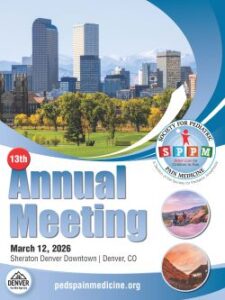A 14-year-old young woman with joint hypermobility presented with bilateral anterior knee pain. It started after a soccer tournament 3 years ago with initial presenting symptoms of knee pain and subjective swelling. She was initially treated with rest, modified weight bearing with crutches, knee brace and NSAIDs. The swelling improved, but the knee pain and kinesiophobia persisted. The pain significantly increases with any active or passive knee flexion. She maintains the knees in full extension the majority of time even when she sits.
Physical examinations are notable for mild bilateral patellar alta, mild lateral tilt of the patellae, internal rotation of the tibia, mild genu valgum, exquisite tender to palpation at the inferior patellar tendon, positive Hoffa’s fat pad impingement test.
Radiographic images were normal.
Which of the following syndromes is most suggested by the presentation outlined above?
Correct!
Wrong!
Question of the Month - May 2023
 SPPM 13th Annual Meeting
SPPM 13th Annual Meeting